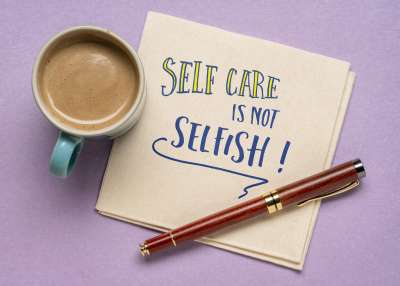Read on as Linda K. Valloor (M. Ed) shares manageable strategies teachers can use to maintain a healthy work-life balance.

Grading, lesson planning, faculty meetings, and researching new ideas are just a few parts of the job that can be overwhelming and time-consuming. Let’s not forget that teachers are people outside of their profession. They have to leave the building or jump offline at some point!
Maintaining balance is the key to embracing a lifestyle that is positive and enjoyable. There are many negative outcomes to living a life that is not balanced; the effects can be detrimental to your physical health, mental well-being, and personal life. Such imbalance contributes to teachers feeling overstressed in a field that is already too demanding. In fact, according to Education Support, 70% of those working in education in 2021 reported that workload was one of the main reasons they wanted to leave their jobs1. Heavy workloads are only manageable when you balance that demand with other elements of your life.
So how do you know if you are off-balance? Most likely, you will show signs of burnout. If you are feeling emotionally or physically exhausted more often than not, distancing yourself from dependable and healthy relationships, experiencing headaches and stomachaches, or seeing that you are not performing your best, you may need to take the time to focus on how to lead a lifestyle that embraces the idea of balance.2
Strategies for a Healthy Work-Life Balance
Finding and maintaining balance requires a certain amount of dedication, and it is well worth it. It gets easier as you adapt to your new lifestyle. It will take time and practice, but it does not have to be complicated. In the end, maintaining balance is about adopting techniques to help in managing stress and improving mental wellness.

Strategy 1: Establish Realistic Boundaries
Boundaries are important when you are a teacher. The truth is, you probably went into education because you are motivated by your ability to make a positive impact.3 This intrinsic motivation will often cause teachers to go above and beyond what is necessary. However, there is a danger in overextending yourself. Setting boundaries and time management can help you avoid this.
Have a set amount of time dedicated to grading or planning lessons during the work day and when you leave work. There will be days when you will take work home, but you need to be fair about how often and how long that happens.
Another way you can set a boundary is by implementing free time during the workday. That may look like ten uninterrupted minutes during your prep or being sure you are using your lunch break to enjoy your meal or to get some fresh air. This may include talking to fellow teachers or even avoiding certain colleagues who tend to pull you into conversations that are not beneficial.
Another important way to set boundaries is to say no. It is healthy to say no to extra tasks and favors. Boundaries will help you create a lifestyle where you avoid burnout altogether instead of simply reducing the effects after the fact.

Strategy 2: Maximise Your Personal Time
It is important for you to not have teaching be your entire identity.4 Take time to pursue activities and hobbies outside of work. Maybe you like to write poetry, play an instrument, peruse the local farmers market, or take long walks. You can be a great teacher while still finding other reasons to smile!
Healthy relationships outside of work are necessary. Even if some of your best friends are your colleagues, it is important to foster community outside of your building. Whether that be through your family, friends, or significant other, balance is achieved when at least one of your important relationships is not connected to your career. You deserve a dinner and conversation in which no topics of school and work are brought up. Keep those moments sacred. Enjoying time away from work with people you value will allow you to live a life that is not solely centered on teaching.4

Strategy 3: Take Time to Focus on Mental Wellness
One way to work toward a better work-life balance is to pay close attention to your mental wellness. Managing stress is an important part of your mental health. Avoiding work gossip, having a confidant or mentor, and being more positive and affirming about your abilities will help you manage your stress levels.5 Honoring those boundaries discussed earlier and valuing those healthy relationships contribute to coping with stress.
It is also crucial to take time for self-care. Self-care refers to activities or habits that help you stay physically and mentally healthy. Caring for your wellness will positively affect the way you view your priorities and your obligations. TeacherVision’s Self-Care Collection provides ample resources on what self-care and wellness entails. Whether it is adopting mindful breathing exercises into your daily routine, taking a moment to practice gratitude, or establishing a good sleep routine, self-care practices create opportunities for teachers to maintain consistent balance in their lives, both professionally and personally.

Strategy 4: Set Clear Goals
The final and important step to maintaining balance is to make clear goals for yourself after you have decided on your specific action plan.1 A lot of teachers love a good planner, so writing down goals may come naturally for you. If it does not, you may want to put a reminder of your daily, weekly, or monthly goal somewhere easily visible so you can hold yourself accountable. Clear goals will support your desire to not fall back into old patterns.
There’s no need to overcomplicate your goal-making process. You can be clear about the action/behavior and the number of times you will need to complete it to reach your goal. If you need to add your reasoning behind the goal so that you have a clear rationale when things get hard, do that. This simple strategy can make a world of difference. When you complete the goal, take the time to celebrate.
When we know better, we can do better. Empower yourself, using these strategies, to maintain a teacher work-life balance, and have a happier and healthier experience.
Sources
1 Work-life balance in teaching. (n.d.). https://www.educationsupport.org.uk/resources/for-individuals/guides/getting-the-right-work-life-balance/
2 Scott, E. (2022, June 15). Tips To Help You Maintain Balance in Life. Verywell Mind. https://www.verywellmind.com/maintaining-balance-in-your-lifestyle-3144738
3 Previte, A. (2019, October 4). Teachers: Set Boundaries to Protect Your Peace. Resilient Educator. https://resilienteducator.com/classroom-resources/set-boundaries/
4 Barile, N. Don’t Let Your Teaching Career Become Your Entire Identity. (n.d.). Hey Teach! https://www.wgu.edu/heyteach/article/dont-let-your-teaching-career-become-your-entire-identity2109.html
5 Hunt, C. (2019, February 16). The work-life balance basics: 10 stress-busting tips for teachers. The Guardian. https://www.theguardian.com/teacher-network/teacher-blog/2013/jun/25/teacher-work-life-balance-stress-tips














